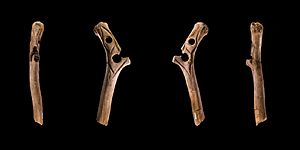Édouard Lartet facts for kids
Quick facts for kids
Édouard Lartet
|
|
|---|---|
 |
|
| Born | 15 April 1801 Castelnau-Barbarens, France
|
| Died | 28 January 1871 Séissan, France
|
| Occupation | Paleontologist |
Édouard Lartet (born April 15, 1801 – died January 28, 1871) was a French scientist. He was a geologist and a paleontologist. He was also a pioneer in studying the Paleolithic Age, which is the early Stone Age.
Lartet is also known for naming an ancient animal called Amphicyon. This was one of the first meat-eating fossil animals ever described.
Contents
A Life of Discovery
Édouard Lartet was born in a small town called Castelnau-Barbarens in France. His family had lived there for over 500 years. He studied law in Auch and Toulouse. But because he had his own money, he chose to focus on science instead.
He was inspired by the work of Georges Cuvier, another famous scientist. Cuvier studied ancient mammals found as fossils. This led Lartet to start his own digs in 1834. He found his first fossils near Auch.
In 1836, he described a fossil meat-eating animal. It was related to dog-like animals. He called it Amphicyon, and this name is still used today. For the next 15 years, he explored the Pyrenees mountains. He found ancient ape fossils that were similar to early humans.
Uncovering Ancient Human Life
In 1860, Lartet heard about human bones found in a cave in Aurignac. He was also inspired by another scientist, William Pengelly. So, Lartet started looking at the cave systems in the Dordogne region of France.
His first book on the topic, The Antiquity of Man in Western Europe (1860), was very important. In 1861, he published New Researches on the Coexistence of Man and of the Great Fossil Mammifers characteristic of the Last Geological Period. In this book, he showed that humans and extinct giant mammals lived at the same time.
At first, some people didn't believe his findings. But another geologist helped Lartet. This led him to the Vézère valley in the Périgord area. In 1863, he started digging there with financial help from Henry Christy.
Working with Henry Christy
Lartet and Christy's work together changed how we understand early humans. They created a basic way to classify different periods of the Stone Age. This system is still useful today.
They made important discoveries at places like Abri de la Madeleine and Le Moustier. These sites became examples for early Stone Age cultures. Lartet linked these cultures to different animal periods. An early period had many mammoths, and a later one had many reindeer.
Lartet and Christy also found and documented mobiliary art. This is art that can be moved, like carvings on bone. They found this art in the oldest layers of their digs. This discovery completely changed how people thought about early humans. This "home art" was found with both the Aurignacian and the Magdalenean cultures.
Their joint research was first published in a paper in Revue archéologique in 1864. Later, Lartet and Christy published their work as Reliquiae Aquitanicae. The first part came out in 1865. Sadly, Christy died before the work was finished. Lartet continued it until his health failed in 1870.
Many items from their digs are now in museums. You can find them in Toulouse, France, and the British Museum in London. Édouard's son, Louis Lartet, also became a scientist and followed in his father's footsteps.
Recognition and Legacy
Édouard Lartet was a very humble person. But he was also one of the most important founders of modern palaeontology. His work was officially recognized when he was made an officer of the Légion d'honneur, a high French award.
In 1848, he was offered a political job, but he chose to continue his scientific work. In 1857, he became a foreign member of the Geological Society of London. Just weeks before he died, he became a professor of palaeontology at the Jardin des Plantes museum. He passed away in Séissan. In 1869, he was also elected a member of the American Philosophical Society.
See also
 In Spanish: Édouard Lartet para niños
In Spanish: Édouard Lartet para niños
- Antiquity of man
- Boucher de Perthes
- Cave art
- de Mortillet
- Mousterian


